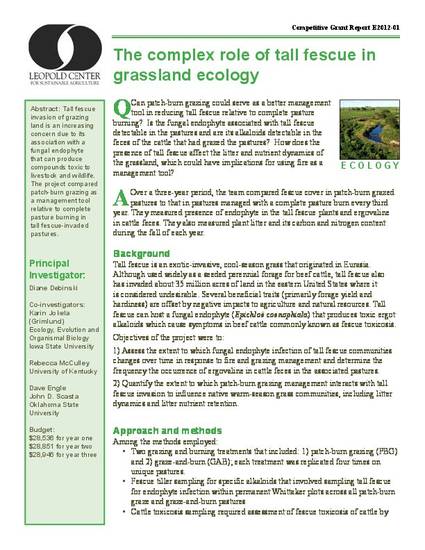
Article
The complex role of tall fescue in grassland ecology
Leopold Center Completed Grant Reports
Project ID
E2012-01
Abstract
Tall fescue invasion of grazing land is an increasing concern due to its association with a fungal endophyte that can produce compounds toxic to livestock and wildlife. The project compared patch-burn grazing as a management tool relative to complete pasture burning in tall fescue-invaded pastures.
Key Question
Can patch-burn grazing could serve as a better management tool in reducing tall fescue relative to complete pasture burning? Is the fungal endophyte associated with tall fescue detectable in the pastures and are its alkaloids detectable in the feces of the cattle that had grazed the pastures? How does the presence of tall fescue affect the litter and nutrient dynamics of the grassland, which could have implications for using fire as a management tool?
Findings
Over a three-year period, the team compared fescue cover in patch-burn grazed pastures to that in pastures managed with a complete pasture burn every third year. They measured presence of endophyte in the tall fescue plants and ergovaline in cattle feces. They also measured plant litter and its carbon and nitrogen content during the fall of each year.
Principal Investigator(s)
Diane Debinski
Co-Investigator(s)
Karin Jokela, Rebecca McCulley, Dave Engle, John D. Scasta
Year of Grant Completion
2015
Disciplines
Citation Information
Diane M. Debinski, Karin Jokela, Rebecca L. McCulley, David M. Engle, et al.. "The complex role of tall fescue in grassland ecology" (2015) Available at: http://works.bepress.com/diane_debinski/68/
